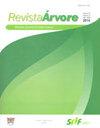用柑橘精油保护松木免受锈蚀
IF 0.8
4区 农林科学
Q4 FORESTRY
引用次数: 2
摘要
天然的颜色会影响人们购买木制品的决定。松木锈蚀是一种真菌导致的松木劣化,它会影响松木的美学属性,通常会导致其被拒收。目的是用柑橘精油控制松木的变色。采用分子方法在属水平上鉴定了松材锈病病原菌为Alternaria sp.、Hypocrea sp.、Trichoderma sp.和Geosmithia sp.。对处理后的松木探针进行了柑橘类精油的吸附和滞留、真菌粘附力和木丝作为真菌生长指标的测定。采用气相色谱法测定精油的成分。真菌对富含d -柠檬烯、γ-松油烯、α-松油醇、香叶醇、丁香酚或β-双abolene的精油敏感。吸附和滞留量数据表明,12.37±1.62 kg/m3是抑制松材真菌粘附和生长的最小用量。柑橘精油能有效控制松木的锈蚀,但保留力差的问题有待改善。本文章由计算机程序翻译,如有差异,请以英文原文为准。
Pinewood protection against sapstain using citrus essential oils
ABSTRACT Natural color influences the decision to acquire a wood product. Sapstain is a fungal deterioration of pinewood that affects its aesthetic attributes and generally causes its rejection. The aim was to control the sapstain on pinewood with citrus essential oils. Causal agents of sapstain on pinewood were identified by molecular methods to genus level as Alternaria sp., Hypocrea sp., Trichoderma sp., and Geosmithia sp. Citrus essential oils were tested to control the fungal growth. For the treated pinewood probes, the adsorption and retention of citrus essential oils, fungal adhesion, and wood satin as fungal growth indicators were determined. The composition of the essential oils was determined by gas chromatography. Fungi were sensible to essential oils rich in D-limonene, γ-terpinene, α-terpineol, geraniol, eugenol, or β-bisabolene. Absorption and retention data suggest that 12.37±1.62 kg/m3 is the minimal amount to inhibit the fungal adhesion and growth on pinewood. Citrus essential oils control sapstain in pinewood, but poor retention should be improved.
求助全文
通过发布文献求助,成功后即可免费获取论文全文。
去求助
来源期刊

Revista Arvore
FORESTRY-
CiteScore
1.00
自引率
0.00%
发文量
32
审稿时长
4-8 weeks
期刊介绍:
A Revista Árvore é um veículo de comunicação científica da Sociedade de Investigações Florestais – SIF. O jornal é de acesso gratuito, revisado por pares, que publica bimestralmente trabalhos científicos originais no campo da Ciência Florestal. As áreas temáticas para publicação são: Ambiência e Conservação da Natureza, Manejo Florestal, Silvicultura e Tecnologia da Madeira e Utilização de Produtos Florestais.
A política editorial visa manter alta conduta ética em relação à publicação e aos seus funcionários, rigor na qualidade dos artigos científicos, seleção de revisores qualificados, respeito profissional aos autores e processo de tomada de decisão imparcial. A Revista Árvore publica artigos apenas em inglês.
Artigos de revisão podem ser publicados se houver uma discussão relevante resumindo o estado da arte sobre o assunto. A revisão estrita da literatura não é aceita.
 求助内容:
求助内容: 应助结果提醒方式:
应助结果提醒方式:


